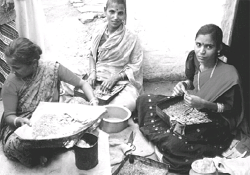The lot of a woman
 The world of work in India, as in many other developing countries, exists mainly in the informal or unorganised sector. Only 4 per cent of women work in the formal sector, with well defined employer-employee relationships and access to all forms of social security, including health security. The remaining 96 per cent are in the informal sector. With insecure employment, insufficient income and lack of access to any form of social security.
The world of work in India, as in many other developing countries, exists mainly in the informal or unorganised sector. Only 4 per cent of women work in the formal sector, with well defined employer-employee relationships and access to all forms of social security, including health security. The remaining 96 per cent are in the informal sector. With insecure employment, insufficient income and lack of access to any form of social security.
The progress made so far in improving women's socio-economic and political status has, in general, raised the standard of their lives and health status. However, they have not benefitted as much from such progress as men have. What is disturbing is the fact that the absolute differences between women have become wider, and the qualitative differences have become more pronounced. It has been suggested that the status of women in any developing country should be taken as an indicator of the health status of their working class women.
The poor, self-employed women have a triple disadvantage: being poor, self-employed and women. Although they contribute in large measure to the gdp , they do not receive an adequate share of the nation's income or employment opportunities. Unlike the formal sector, workers here do not have access to good quality or reasonably-priced health care and generally have to pay a large percentage of their incomes to access even the most basic health care facilities.
When a woman plays the triple role of worker, housewife and mother, she is unable to perform any of the functions satisfactorily because of no access to support services. Lack of child care, for example, means that they have a low productivity as workers as well as poor care for the child. Lack of access to maternal health care means that work affects both the pregnant woman and the unborn child.
They face problems related to their posture of work ( bidi workers, carpet weavers); continuous contact with hazardous material (electronic industry, tobacco processors); their work environment (lack of space, ventilation); their work actions (rag pickers); and physical endurance (cart pullers, construction workers), besides the repetitive nature of the movements.
Most technological developments are introduced with the aim of reducing human effort and maximising profits. These often negatively affect the people involved in production, especially women workers. Thus, while on the one hand, machines are being introduced to make bidis, pierce beads faster, for better quality, faster weaving or in the coal mines, on the other hand it, often results in the displacement and retrenchment of women workers, without offering them any employment alternatives or training facilities.
Modernisation has it ugly side too. Take the use of machines in the manufacture of slate pencils. Mechanisation has rendered the silica and other particles from these processes even finer to inhale. But there is no investment in measures to protect the workers from the ill-effects of this technological advance. At the Mandsaur slate pencil factories, it has been noticed that the morbidity and death rates have risen since the advent of machines.
The laws that exist do not cover the unorganised sector. The self-employed or contractual workers, who happen to be mainly women, are totally devoid of protective legislation.
It is impossible to talk of the uplift of poor, self-employed women without mentioning the role of the Self-Employed Women's Association, or sewa , as it is popularly known . T his trade union is exclusively for women and was formed 1972. It now has around a 2.2 million members consisting mainly of home-based producers, petty vendors and manual labourers. sewa has always focused on the health of women at their workplace. Occupational health is often interlinked with unsanitary living and working conditions. With sewa' s support and guidance, around 100 members were trained as local health workers for their own neighbourhoods.
The 1998 Shram Shakti Report points out that the Constitution of India directs the State to make provision for securing just and humane conditions of work. But until that happens, workers will continue to toil in an environment that poses a threat to their health at far-from-adequate wages.
The writer is secretary-general of Self-Employed Women's Association, Ahmedabad.
Related Content
- Women, business and the law 2024
- Born too soon: decade of action on preterm birth
- Undernourished and overlooked: a global nutrition crisis in adolescent girls and women
- Trends in maternal mortality 2000 to 2020
- Protect the Promise: 2022 progress report on the every woman every child global strategy for women’s, children’s and adolescents’ health (2016–2030)
- Order of the National Green Tribunal regarding dumpsite remediation, Coimbatore, Tamil Nadu, 17/10/2022
